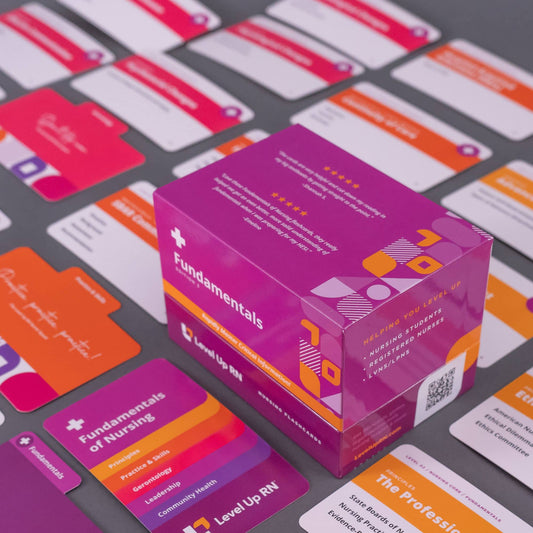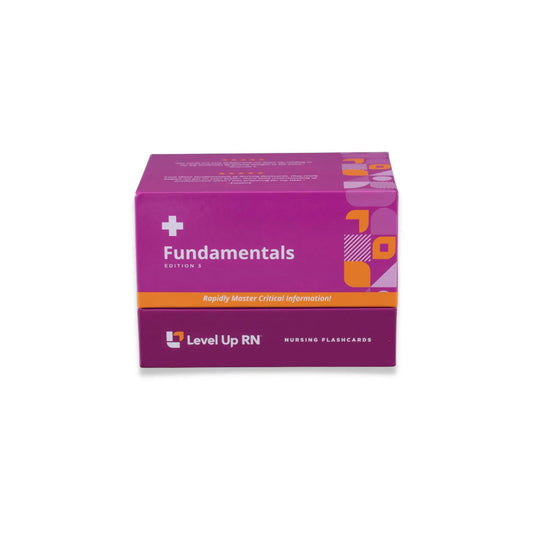Fundamentals - Community Health, part 6: Health Risks and Family Nursing
Updated: Ellis ParkerHealth risks across the lifespan by discussing health risks specific to infants, children, adolescents, and adults, including any related family or patient teaching. Family nursing is also discussed by reviewing the family systems theory and family assessment tools. These tools include the genogram and ecomaps.
Full Transcript: Fundamentals - Community Health, part 6: Health Risks and Family Nursing
Full Transcript: Fundamentals - Community Health, part 6: Health Risks and Family Nursing
Hi, I'm Ellis with Level Up RN. We're going to continue our discussion on community health nursing by moving into health risks across the lifespan, which covers two cards, as well as family nursing. These cards are found in the community health section of our fundamentals flashcard deck. If you have that deck, you can grab these cards and follow along with me. If you don't have the deck, be sure to check us out at leveluprn.com. After we review the content on the cards, hang tight because I have some questions to test your knowledge. Let's get started with health risks across the lifespan, and this is simply breaking the lifespan up into age ranges and identifying health risks faced by each age range. Especially when we're talking about individuals under 18, infants, children and adolescents, we also are going to point out the important family teaching aspects, right? A primary role of the nurse is to be an educator. And if we can provide family teaching to decrease the incidence of these health risks faced by these children and pediatric patients, then we absolutely want to make sure that we're doing that. So we'll start at the beginning of the lifespan with infants. Health risks specific to infants include congenital defects, being preterm or having a low birth weight, experiencing sudden infant death syndrome or SIDS, as well as accidental injuries, one of which being suffocation. So priority family teaching is going to include prenatal care, the benefits of breastfeeding, and then a focus and emphasis on sleep safety, part of which being make sure that we put the baby on its back for all sleep.
Health risks specific to children also includes accidental injuries, but these ones are going to be more related to sports or being active, so bicycles and skateboards, and also though includes things like choking and drowning. Children also have a health risk for childhood obesity. Important family teaching includes car seat safety, wearing protective equipment for sports or biking like helmets. It's also going to include healthy eating and exercise discussions and then making sure that the children stay up-to-date on their immunizations. Health risks specific to adolescents include mental health disorders, substance use, smoking, motor vehicle accidents, and STIs. Family teaching for adolescents is going to include safe sex practices and/or abstinence, motor vehicle safety like wearing your seat belt, and don't text and drive or drink and drive, or anything like that. It also is going to include monitoring for substance abuse and mental health issues. The final age range I'll cover in this section is going to be adults, and these are adults up to the age of 65. We actually have a whole nother section that is just for the older adult, and if you're looking for content on that, make sure to check those videos out. But for now, I'm just going to chat about the health risks faced by the average adult to the age of 65-ish.
The health risks faced by this group is simply additional chronic diseases because as one ages, one is more likely to develop something. These diseases include things like cardiovascular disease, diabetes, mental illnesses, obesity, as well as different types of cancers. There are also a variety of reproductive health issues that are, of course, going to be dependent based on the reproductive organs that one possesses. So patients who are female have just generic reproductive health issues. They'll also experience menopause, and they have higher incidences of breast cancer and osteoporosis. Patients who are male are going to have health risks that include prostate and testicular cancer. Patient teaching for this age range includes a focus on preventative care, so annual wellness exams and then educating patients on self-examinations depending on what reproductive organs they have for things like breast self-exams or testicular self-exams. We can also recommend and refer screenings dependent on the patient again, and these include things like mammograms or prostate cancer screenings. And we're also going to chat about healthy lifestyle choices. For example, we might recommend weight-bearing exercises for individuals at higher risk of developing osteoporosis.
Now that we've covered health risks across the lifespan, let's transition into family nursing. And to begin, we'll chat about the family systems theory because it's important to understand the family as a whole is sometimes our patient. The family systems theory posits that a family is an interdependent unit. They're all connected to each other, and so what happens to one person, whether it's a change or a stressor, is going to have an impact on the rest of the family unit. There are different tools that we can use to assess families, whether that is their health and health history or their relationships with each other or the outside world. The first tool is the genogram. A genogram is a graphic representation of a family tree, and it usually covers three generations. It can and is often used to depict medical or health history so that we can recognize patterns. The CDC does offer a way to build a genogram. It's called My Family Portrait. A second assessment tool is an ecomap. An ecomap is a diagram that highlights the relationships between individual family members as well as outside systems like school or work or extended family members. And a key point to remember when working with families is that transitions are a period of increased risk. And these transitions can be normal life events like the birth of a child or graduating high school, but it can also be unexpected events like the loss of a family member, the loss of a job, or divorce.
And that wraps up the content for this video, so just hang tight and I'm going to ask you a couple of questions to check your knowledge. List at least three key family teaching tips that are related to health risks faced by children. Family teaching for health risks specific to children includes car seat safety, protective equipment for sports, healthy eating, physical activity or exercise, and staying up-to-date on immunizations. Identify a health risk specific to adolescents. Adolescent health risks include mental health disorders, substance use, smoking, motor vehicle accidents, and STIs. Define the family systems theory. The family is an interdependent unit, so a change or stressor faced by one individual is felt by the entire family. Thank you so much for studying with me. I hope you learned something. In my next video, we'll be moving on to community health plans and a community assessment.


